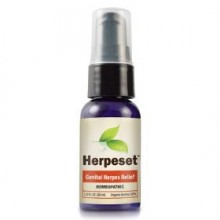Stressed out, exhausted and run down? The last thing you need now is a fever blister. Unfortunately that’s when they’re most likely to strike. But there’s never really a good time to get a fever blister. They’re itchy and painful and your lip feels ten times bigger than normal. They take ages to heal and in the meantime you feel ugly and diseased. Not to mention the damper it puts on your love life.

Fever blisters are common in very visible areas such as the face, where you least want them.
Although fever blisters aren’t unusual, they are annoying. You might get them several times a year and the problem is they’ll never go away completely. If you suffer from regular outbreaks, this can be a very depressing thought. While your doctor might prescribe something that will shorten the duration of your outbreak, he cannot cure it.
But, if you educate yourself about your condition and research alternatives, you’ll find a solution that works for you. Fever blisters are often nothing more than a symptom of a larger problem. They are caused by a virus that is almost impossible to destroy. The more you understand about how the virus operates, the better you’ll be able to avoid future flare-ups.
Before getting in to how to get rid of fever blisters, some basics:
Table of Contents
Understanding the Cause of Fever Blisters
Fever blisters, or cold sores, are a result of a virus called Herpes Simplex Virus 1 (HSV1). It normally affects the lips and areas around the mouth. Most people are infected as children and at least half of the world’s adult population carries the disease.
The initial infection often appears with cold or flu-like symptoms. You may get a headache, fever and sore muscles. After the first infection, the virus retreats into the nerves where it lies dormant until it is triggered again. Subsequent infections may not be as serious, but the virus will always remain in your body.
Some of the things that may trigger a recurrence are:
- Fever
- Stress
- Fatigue
- Hormonal changes
- Exhaustion
- Compromised immunity
Taking care of your health, getting sufficient rest and reducing stress can help you to reduce the chances of a reoccurring infection.
How Contagious are Fever Blisters?
The virus does require direct skin-to-skin contact to spread. Kissing someone with a fever blister is the most obvious way to get infected. But even shaking hands with someone who has recently touched their fever blister can also transfer the virus.
If you have a fever blister, you’ll need to take extra precautions if you engage in oral sex with your partner. Although the HSV-1 virus is the most common cause of oral herpes, you could give your partner genital herpes.
People with weaker immune systems are especially vulnerable. Young children and sick people will not be able to fight the virus and may experience complications. Even if you don’t have any symptoms, you can still spread the virus. Although there are long periods when the virus isn’t active, it sheds for a few days every month.
Luckily the virus can be killed with soap and water. So wash your hands regularly and avoid sharing eating utensils to prevent spreading the virus to your loved ones. You should also wash your bedding and towels in hot water to avoid infecting your family.
You can even spread the virus to other parts of your body. Fever blisters can be very itchy but you need to resist scratching them. Even the scabs can be infectious, so try to keep your hands away from your face. Not only will it reduce the risk of spreading the disease, but it will also help your skin heal faster.
How are Fever Blisters Treated?
A doctor will be able to diagnose your condition simply by looking at your blisters. A fever blister is easy to identify and distinguish from other kinds of sores. Along with symptoms such as tingling and itching, the collection of pus-filled blisters is very distinctive.
If you’re just looking for relief, your doctor may prescribe an ointment to relieve your discomfort. But these are only effective if you start applying them at the first signs that a fever blister is about to erupt. For more severe cases you may need to take a course of antiviral medication. You may need to swallow a pill twice a day, or insert one under your lip which dissolves throughout the day.
Along with this, he or she may prescribe a steroid cream to reduce the inflammation and swelling caused by the blister. A steroid cream can only be used if you’re taking antiviral medication. This is because steroids can decrease your body’s ability to fight infections.
Although you’ll get some relief from the pain, and your fever blister may heal faster, it won’t have any effect on the virus itself. The medication itself can be unpleasant and there are a number of dangerous side-effects that accompany this kind of treatment.
Your doctor may explain to you that there is no cure for herpes and you’ll be susceptible to outbreaks for the rest of your life. For many people, this can be a depressing scenario that they aren’t willing to accept. Which is a good thing, because as it turn out, there are other options.

There are options you won’t learn from your doctor, either because they don’t know about them, or because they’re not allowed to recommend natural treatments. More on that later.
Are Natural Remedies Better at Treating Fever Blisters?
Fever blisters have been around for centuries. They were so common in Ancient Rome at one point that Emperor Tiberius banned kissing in an attempt to stop the epidemic. Over time, natural healers have discovered many plants that are able to heal fever blisters quickly and effectively.
Many of these alternative cures are readily available and inexpensive. They may even reduce the number of flare-ups and have the potential to completely eradicate the virus. This is because they support your immune system, helping the body rid itself of the virus.
Some popular remedies that have brought relief to millions of people include the following:
- Tea tree oil: It has powerful antiviral properties. It can kill the particles of the virus that appear on the blister as it erupts. It also keeps the area clean and free of infection so your blister will heal faster. It can be strong, so dilute the oil with some water before you apply it to your skin.
- Garlic: Another excellent antiviral, garlic paste applied to the blister for ten to fifteen minutes at least three times a day will disinfect the blister and decrease the healing time.
- Liquorice root powder: The active ingredient in liquorice, glycyrrhizin, is both an antiviral and anti-inflammatory. It provides instant relief from itching and burning and minimises the redness. You can use it as a paste, or drink it as a tea to promote faster healing.
- Tumeric: You can’t find a better anti-oxidant than turmeric. It fights free-radicals to promote fast healing. Like liquorice, you can either apply it as a paste or drink a teaspoon dissolved in warm milk.
- Honey: Excellent for healing any skin condition, honey keeps the area clean and promotes healing.
- Coconut oil: It’s antiviral, antibacterial and antifungal. Coconut oil repairs damaged cells and tissues and ensures that your blister won’t linger very long.
While any of these will help you get rid of the odd fever blister, a product called Herpeset can do even more.

Herpeset is the name of a homeopathic remedy for fever blisters/cold sores that gives great results due to a synergistic mix of many individually effective herbs.
Herpeset is a natural product that combines the strengths of several fever-blister-busting ingredients. Not only does it heal fever blisters quickly, but regular use can also prevent future outbreaks. Both plant extracts and homeopathic preparations are used in a spray application that reduces the tingling, itching, burning and swelling—as well as reducing the appearance of the fever blister.
It includes Rhus tox and Apis Mellifica which provide near instant relief from the itching and burning sensations that accompany the onset of a fever blister. Capsicum is added to bring pain relief while Baptista and Nitricum Acidum help with healing ulcers and broken, bleeding skin. Finally, Pyrogenium speeds up the healing process.
Unlike most remedies, you don’t apply this to your blister directly. Instead, you spray it under your tongue where it’s absorbed directly into your blood stream. It gets to work fast and helps your immune system fight the active virus. Many people who have used Herpeset report a significant reduction in the number of outbreaks they experience. Best of all, it’s completely safe to use and far more affordable than prescription creams. If this sounds interesting you can learn more from the official website here.
Is It Really Impossible to Cure Herpes? How to Get Rid of Fever Blisters For Good
Modern medicine will tell you that at the moment, no cure exists for the Herpes Simplex Virus. However, alternative medicine takes a different view. While there is no pill you can take that will completely remove the virus from your body, you can be cured.
But it requires a long-term approach and you will need to change your lifestyle. The body actually has the ability to heal itself. For example, when you catch a cold you may have a runny nose. This is unpleasant, but it’s a sign that the body is fighting an infection. Medicine may help relieve your symptoms, but it’s your body that defeats the virus responsible for your illness.
A strong immune system is your best weapon for fighting herpes. Unfortunately our modern lifestyles leave us stressed and undernourished which leads to a weakened immune system. To remedy this you can start doing the following:
- Take a lysine supplement: Lysine is an essential amino acid that the body requires for many important functions. Your body cannot produce it so you need to get it from your diet. Lysine blocks another amino acid, arginine. The herpes virus uses arginine to replicate. By increasing your intake of lysine, you can stop the herpes virus from replicating and reduce your outbreaks.
- Reduce your stress: Late nights and early mornings place stress on your body, especially your immune system. Getting sufficient sleep every night gives your body a chance to recuperate.
- Take care of your skin: A surprising trigger for fever blisters is sun exposure and dry skin. Use a sunscreen every day and keep your skin hydrated.

The Ultimate Herpes Protocol focuses on getting rid of the virus for good and not just hiding the symptoms.
Boosting your immune system is a good place to start, but it takes more than that. In her eBook, The Ultimate Herpes Protocol, Melanie Addington reveals the secret to breaking down the virus itself.
After being diagnosed with genital herpes, Melanie felt ashamed and depressed. The pills her doctor prescribed made her ill and even switching to another brand didn’t help. Eventually she overcame her embarrassment to speak to her father about it. Even though he was a conventional doctor, he refused to believe that this disease couldn’t be cured.
Together they devised a protocol that not only strengthens the immune system, but also attacks the virus. The key lies in destroying the protective protein coating that surrounds the virus. This leaves it vulnerable and your own immune system will have no trouble destroying it. But, viruses tend to replicate when they are under attack in order to preserve themselves.
The Ultimate Herpes Protocol will also show you how to prevent the virus from making copies of itself. With this three-pronged approach, the virus can be completely eliminated from your body. You’ll never have to worry about infecting others and you’ll never have another fever blister again.
It seems too good to be true, but Melanie has already received positive results with over 7500 people who have used the protocol. This is not a quick-fix solution. But if you’re serious about getting rid of herpes, and you’re willing to put in some effort, The Ultimate Herpes Protocol has the solution.
You can click here learn more from the official Ultimate Herpes Protocol website.
Fever blisters are really just the tip of a much more serious problem. Not only are they painful and ugly, but they can make your life a misery. Many people are unaware that they are actually an indication of a contagious virus. Doctors can only help you treat the symptoms and not the cause. On the other hand, alternative medicine can help you treat both.
It’s easy to be sceptical, but there are many people who have found relief using natural remedies. Some have even been able to rid themselves of the virus completely—and so can you. Holistic medicine works with the body and won’t upset the natural balance. It’s cheap, effective and improves your overall health. Can you imagine never having to worry about a fever blister again?
